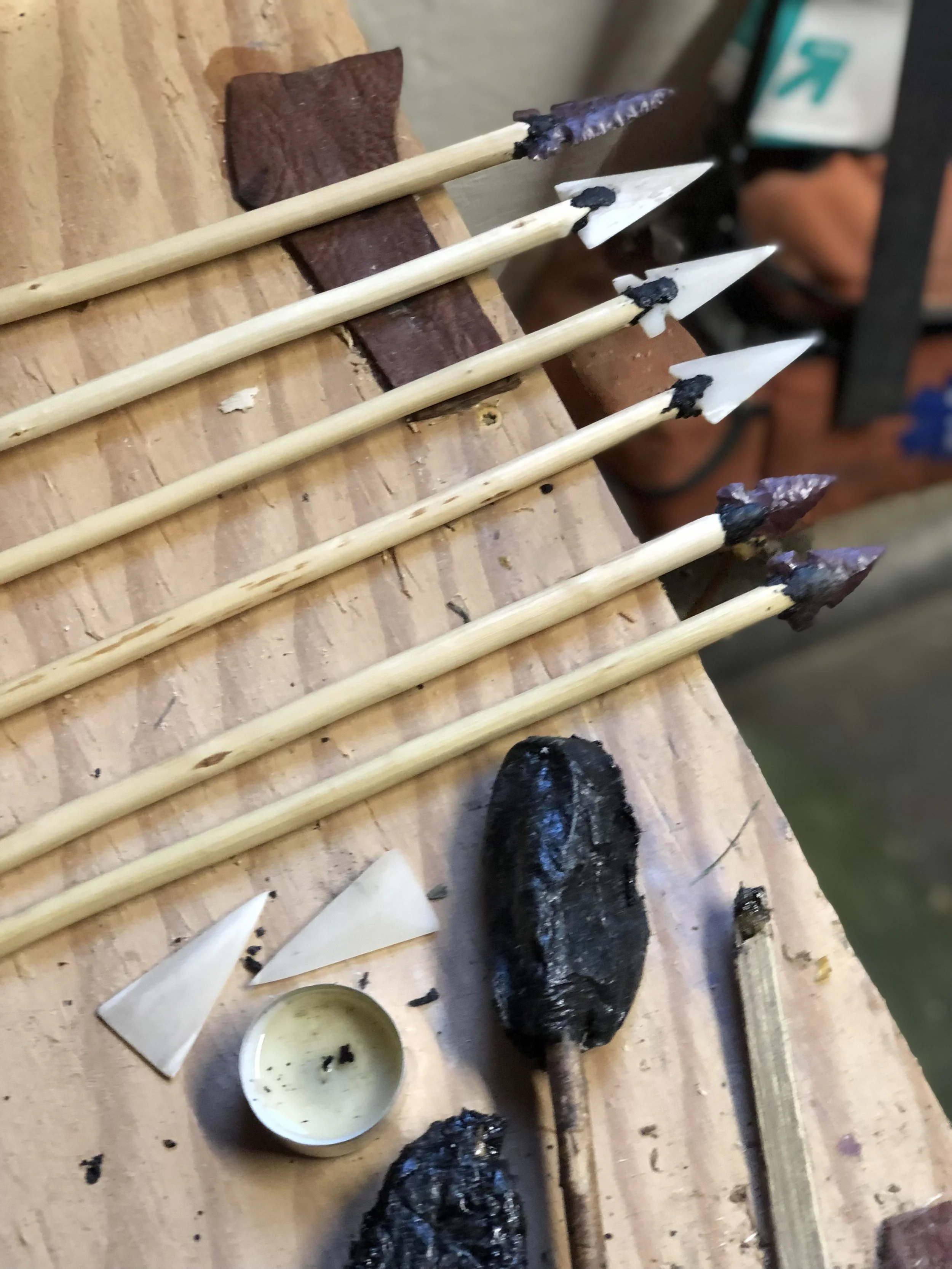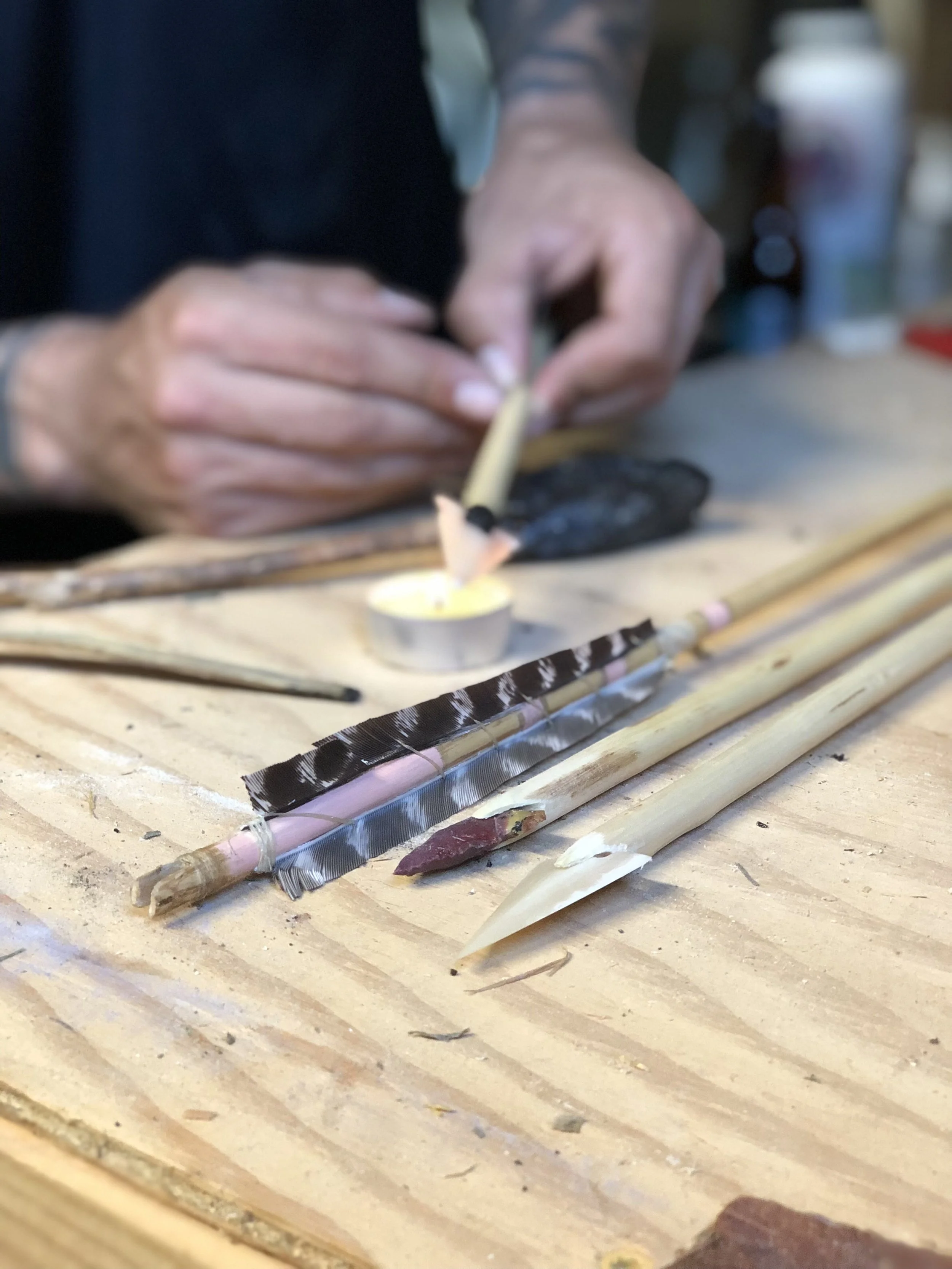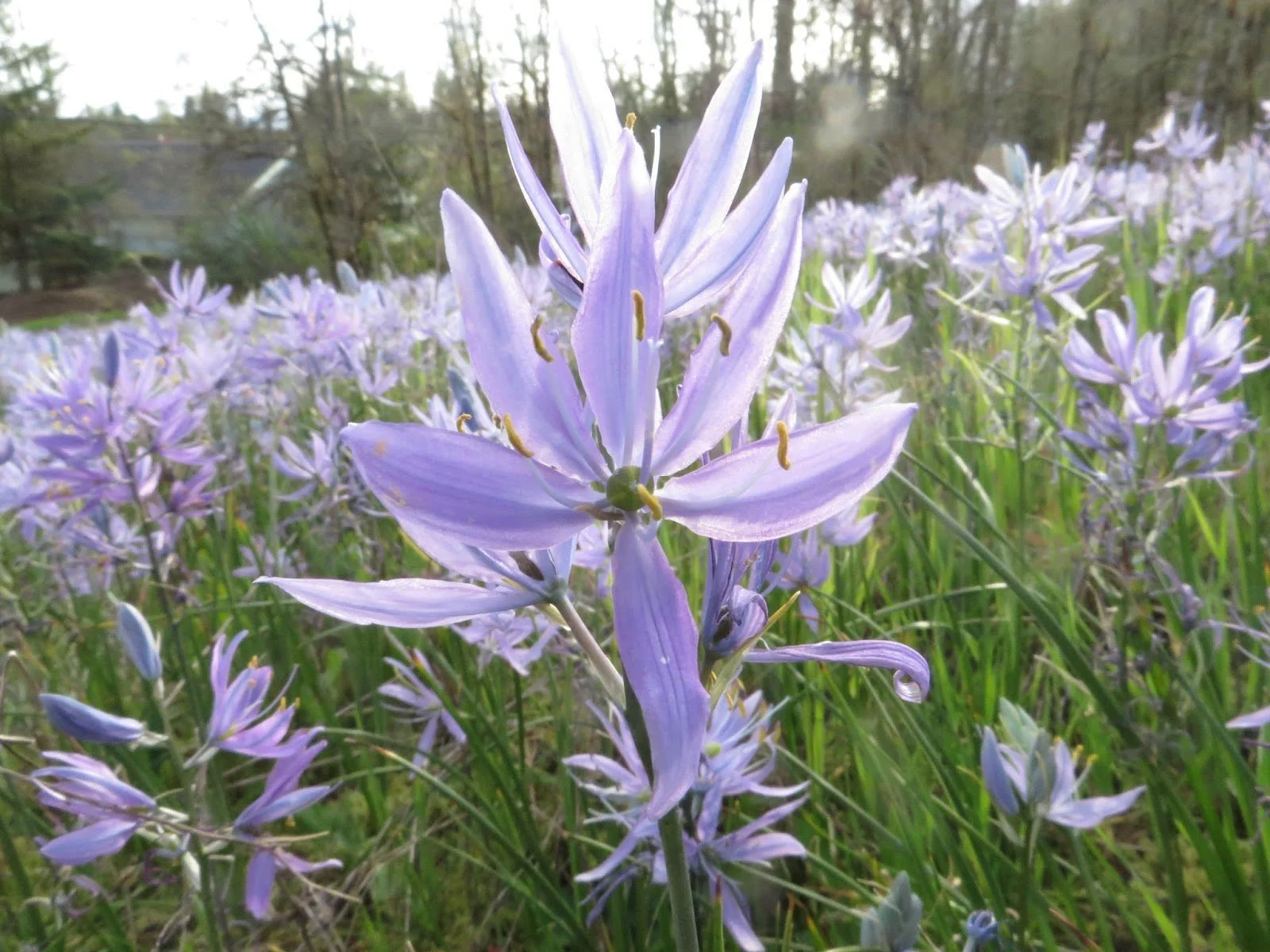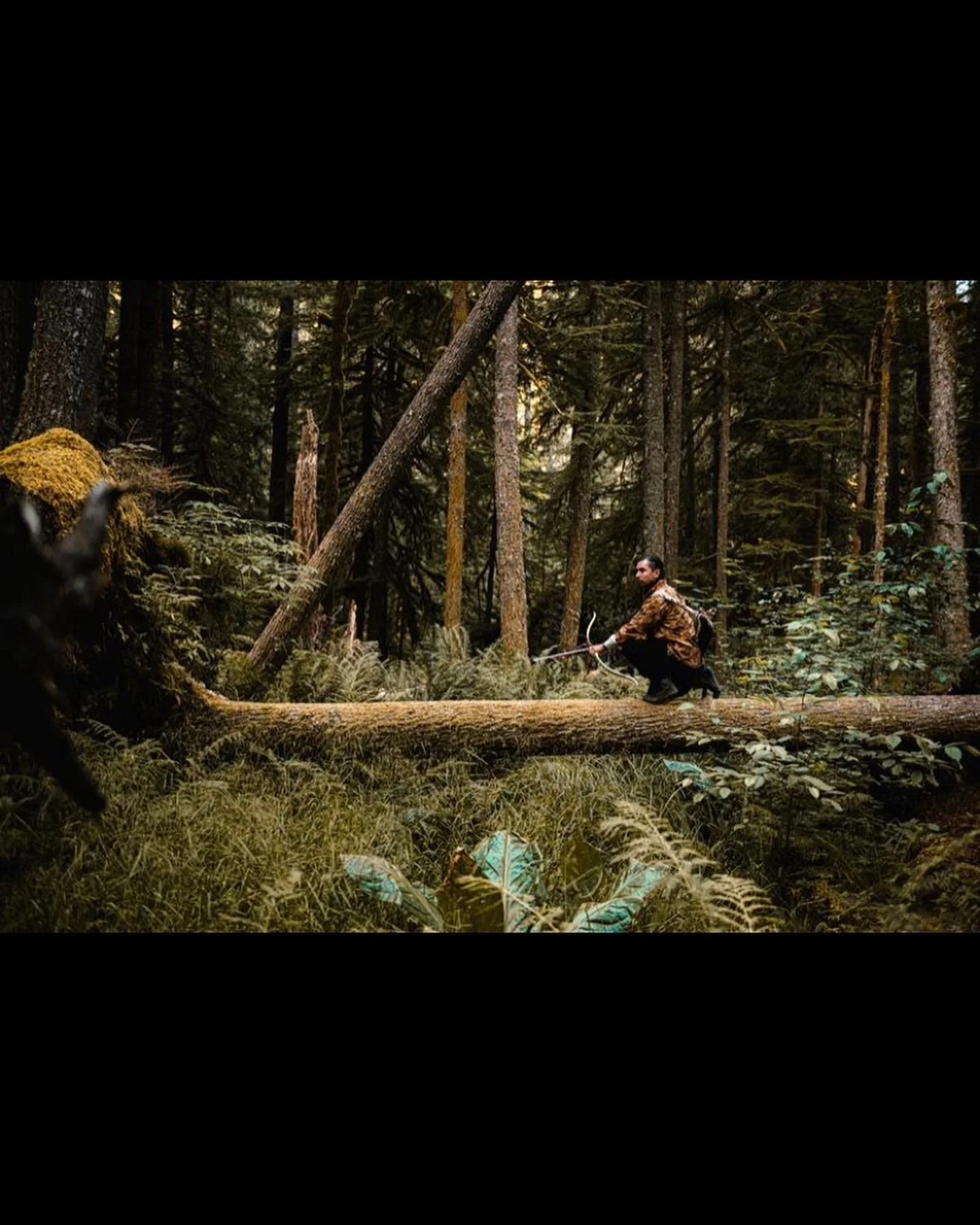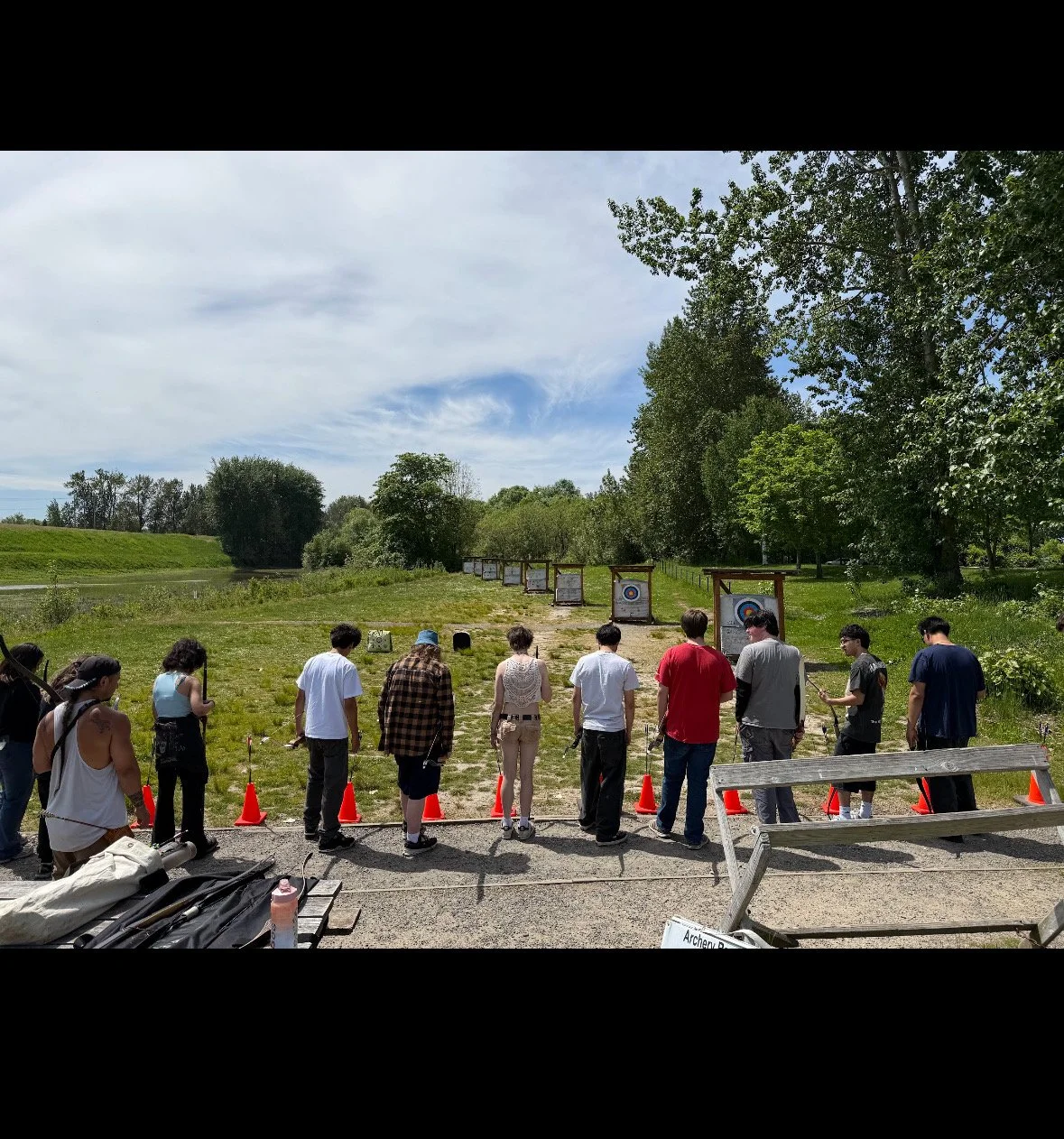
Our attitude is that of gratitude and acknowledging the life force that has been taken to produce a tool for learning life’s lessons from the natural world.
The Program
Welcome to Learning through Land (LTL). Below are the sections of our 9 month program. We will offer ancestral learning opportunities for community abroad such as archery basics, fire and knife safety, traditional arrow making, and bow making clinics, hide tanning , flint knapping, arrow making, flint knaping, traditional bow making, plant ID journals, animal tracking basics, archery field day with the bows we made. These sections will also include leather work and stitching, nature awareness, outdoor survival skills training, camping and conservation work tending to land. Through these courses we aim to create healthy spaces where communities can thrive in their journey to build their skill sets to be able to teach others as leadership roles are essential in our lives to hold the fabric of these skills that are often overlooked by modernity.
Archery Basics
-
Time commitments - 2 days Saturday and Sunday (9am-3pm)
Students- 6-10
Staff and volunteers- 2 staff members and 4-6 volunteers.
Tools required- bows and arrows, targets, safety cones, protective equipment for fingers and arms, archery sign with rules and procedures.
-
We begin with two archery events where participants and their families can join us to the arts of this sacred practice and learn the safety, rules and commands of the archery range, how to string and operate their equipment safely leading to the form and functionality of the shot process guiding their arrows safely to the target.
Fire and Knife Safety
-
Time commitments - 2 days Saturday and Sunday (9am-3pm)
Students- 6-10
Staff and volunteers- 2 staff members and 4-6 volunteers.
Tools required- wood for carving , spindles, wood fireboards, handholds, bows (paracord cordage & curved stick), carving tools (knives) , lubricant for handhold, tinder, outdoor fireplace, water bucket.
-
Our next session will focus primarily on knife carving safety, form and functional carving techniques utilized in bushcraft training for wilderness survival. Learning the fundamentals of carving such as forward cut, beaver chew, stop cut , double thumb push cut and proper tapering and square formation techniques. This will also include making a bow drill kit from scratch utilizing natural wood materials we collect from the land such as cedar, cotton wood, hazel and other species of wood that are available for fire by friction methods.
Traditional Arrow Making
-
Time commitments - 2 days Saturday and Sunday (9am-3pm)
Students- 6-10
Staff and volunteers- 2 staff members and 4-6 volunteers.
Tools required-11/32 or 5/16 diameter Arrow shafts, backstrap sinew, feathers for fletching, wood glue or hide glue, razor blade or box cutters for splitting fletching, scissors, measuring tape. Thin long round files for carving knocks on both ends of shafts.
-
Our next session will be focused on arrow making. We will use natural wood materials such as Douglas fir , ocean spray, red osier dogwood, mock orange, nine bark and wild rose. We will then process turkey feathers for the fletching and sinew for adherence of the fletching to the shaft material. We will follow up on the previous skill of fire by friction to make a small smokeless fire for hand straightening the arrow shafts to heat up the spots of the arrow that needs straightening for maximum efficiency.
Flint Knapping (arrowheads)
-
Time commitments - 2 days Saturday and Sunday (9am-3pm)
Students- 6-10
Staff and volunteers- 2 staff members and 4-6 volunteers.
Tools required-Obsidian, thick leather for legs when spalling, Leather and wood crash pads for pressure flaking, copper boppers, copper pressure flakers, rough stones for abrasion on edges of stone, safety goggles, protective gloves, paint pens for drawing shapes of arrow heads. Sap form pine or other trees for glue.
-
To complete the arrow making process we have to dive deep into the ancient methods of flint knapping. Creating arrow heads from stone, volcanic glass and bones from elk or deer . This is an extremely extensive process and needs 2 full days to really dive deep into the process so students understand what it takes to not only make arrow heads but how we can teach someone else about what steps are involved. Once arrow heads are made, we follow up with the arrows we began earlier by hafting the arrowhead to the shaft with the sinew we already processed in previous lessons.
Traditional Bow Making
-
Time commitments - 2 weekends Saturday through Sunday (9am-5pm) all 4 days.
Students- 6-10
Staff and volunteers- 2 staff members and 4-6 volunteers.
Tools required- wood staves for bow making, measuring tapes/ Chalk lines / Saws/ Draw knives/ Hatchets/ Sharpies / pencils/ tilering strings/ rasps/ String bundles (Dacron)/ card scrapers/ nock files/ carving knifes, wood stumps, clamps.
-
This is a 4 day (2 weekend) commitment teaching students the basics of wooden bow making made from locally gathered materials such as Oregon Ash, black locust, hazelnut, vine maple, red osier dogwood and other native species. Here students will learn how to craft a bow using hatchets, draw knives, rasps, and even make their own bow string using the reverse wrap cordage method. This is a slow process but well worth the effort and dedication to reclaim this practice that many of our ancestors utilized for hunting food and learning about the natural world and how we can find balance in our lives
Plant id Journals
-
Time commitments - 2 days Saturday and Sunday (9am-3pm)
Students- 6-10
Staff and volunteers- 2 staff members and 4-6 volunteers.
Tools required- journals, pencils measuring tapes, pojar books, compasses.
-
As a nature education organization , we justly incorporate the harvest of wild or homestead cultivated food in our curriculum. In this session, Students will learn the basics and intermediate knowledge of trees and plants in forested areas. Fully trained in the identification of edible, toxic and natural materials ideal for making tools.
Animal Tracking Basics
-
Time commitments - two Sundays (9am-3pm)
Students- 6-10
Staff and volunteers- 2 staff members and 4-6 volunteers.
Tools required- journals, pencils, compasses.
-
Archery Field Day
-
Time commitments - 1 day on Sunday (9am-3pm)
Students- 6-10
Staff and volunteers- 2 staff members and 4-6 volunteers.
-
This is a celebration day for our students to come full circle on their journey in making traditional equipment and putting them to the test. This will also be a formal ceremony of completion and welcoming students and their families to attend. We will have target practice leading up with students teaching their families how to use bows in arrows to encompass leadership skills and translating the lessons to their families.


